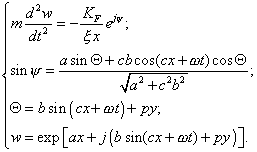| SELF | 108 |
| S.B. Karavashkin and O.N. Karavashkina | |
|
|
Thus, to find the body trajectory within the studied power field, we have to solve the following system of equations: |
|
|
(23) |
As we made without any assumptions all pre-conditions which take into account the features of body motion in the studied power field, conveniently solve (23) numerically. To compose the calculation scheme, divide the studied time
interval into a large number n of equal sections |
|
|
(24) |
where The second integral over the time we can found the same: |
|
|
(25) |
where the constant C20 is determined by the co-ordinates of initial location of the body in the plane W. In fact, the recurrent relationships (24) and (25) determine the velocity and location of the body in the plane W in the end of each small time interval. To make them working, we have to establish the relation between the prototype and image co-ordinates of the point location in the beginning of each small time interval. Conveniently use the stationary non-conformal mapping (the last expression of (23)). As the selected interval is small, we can write enough accurately: |
|
|
(26) |
Passing sequentially the time intervals, at each of them
determine the left-hand part of (26), calculating (24) and (25). We can determine the
particular derivatives of the right-hand part of the system, differentiating the last
expression of the system (26) with respect to x and y and substituting
the values, corresponding to the beginning of each time interval. So, solving (26) with
respect to |
|
|
|
In Fig. 6 we show the body motion trajectories calculated
with respect to the field transformation frequency We see that in a stationary power field ( With the time transformation of the field, the trajectory
displaces to the sink axis (clockwise), and its length diminishes, but the pattern
complicates. The trajectories corresponding to In the following frequency raising, the trajectory length
grows again and the trajectory itself goes on turning clockwise, but only up to With diminishing mass, the body motion in a crater-like harmonic field retains its described regularities, though becomes more chaotical and the lines of force repulse the body more often. |
|


